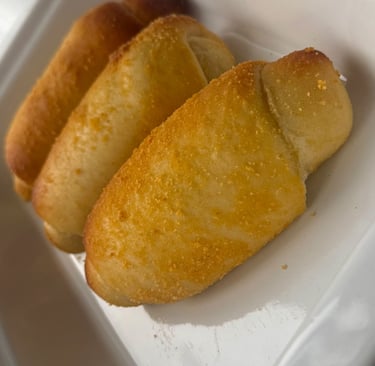Spanish Bread: The Sweet, Buttery Roll That's Purely Filipino
Spanish Bread is a quintessential Filipino pastry—a soft, enriched dough roll filled with a sweet, buttery mixture of breadcrumbs, sugar, and milk. Shaped into a tapered log and coated in more breadcrumbs, it bakes to a golden, crisp exterior with a warm, gooey center. Despite its name, it has no Spanish origin; it’s a homegrown creation born from colonial-era ingenuity, now a beloved merienda staple sold fresh from neighborhood panaderías for just a few pesos. Simple, nostalgic, and irresistibly comforting.
Lola Inay
11/13/20253 min read


In the heart of every Filipino panadería, amid trays of golden pandesal and coconut-filled pan de coco, sits a humble yet irresistible treat: Spanish bread. Not to be confused with its salty namesake from across the ocean, this señorita bread (as it's sometimes called) is a soft, enriched dough roll stuffed with a decadent mix of butter, sugar, breadcrumbs, and milk. Rolled into a log, coated in more crumbs, and baked to a crisp-edged perfection, it's the ultimate merienda (snack) that evokes childhood memories of bicycle vendors hawking warm loaves through humid streets. Despite the moniker, Spanish bread has zero ties to Iberian baking—it's a 100% Filipino creation, a testament to colonial adaptation and local flair.
A Name Without a Passport: Origins in Colonial Ingenuity
Spain's 333-year rule over the Philippines (1565–1898) left indelible marks on the archipelago's cuisine, from adobo to ensaymada. Wheat bread arrived via Manila galleons, but scarce imports and tropical humidity demanded reinvention. Filipino bakers—often Chinese-Filipino entrepreneurs—took basic Spanish dough techniques and infused them with affordable staples like sugar from Negros canefields and recycled breadcrumbs to stretch ingredients.
The result? A bread born in the late 19th or early 20th century, likely in urban bakeries adapting to post-colonial tastes. Unlike Spain's dense pan de horno (rustic oven bread), Filipino Spanish bread is soft, slightly sweet, and filled for indulgence. Historians like Doreen G. Fernandez, in her writings on Filipino food evolution, highlight how such breads represent creolization: foreign forms filled with Pinoy soul. By the American era (1898–1946), it joined the "Filipino bread basket" alongside pandesal, becoming a staple in neighborhood ovens fired by wood or coconut husks. Today, it's mass-produced by chains like Goldilocks and Red Ribbon, but the best versions still emerge from corner panaderías, their horn-shaped logs a far cry from any European ancestor.
The Magic of the Filling: Texture and Flavor in Every Bite
What sets Spanish bread apart is its signature palaman (filling)—a gooey, caramel-like paste of breadcrumbs soaked in melted butter, brown sugar, evaporated milk, and a whisper of vanilla. The dough, akin to enriched pandesal but softer and eggier, is proofed, flattened into ovals or triangles, slathered with the mixture, and rolled from one end at an angle. This creates a tapered, crescent-like shape that mimics a senorita's silhouette—hence the alternate name.
Dusted generously with breadcrumbs before baking, the exterior crisps into a golden armor that yields to a fluffy crumb inside. Fresh from the oven, the filling oozes warmly, balancing buttery richness with subtle sweetness. It's not cloyingly sugary; the breadcrumbs add a nutty, toasty depth, while the milk lends creaminess. Regional twists abound: some add a pinch of salt for contrast, others incorporate condensed milk for extra decadence. In Los Baños, Laguna, or Quezon City's old bakeries, you'll find variations baked in traditional pugon ovens for that smoky edge.
A Snack for Every Soul: From Street to Table
Spanish bread is more than fuel—it's comfort in roll form. At 5–10 pesos a piece, it's democratic street food: kids clutch them after school, jeepney commuters snag bags for the ride, and manongs (uncles) dunk them in instant coffee or tsokolate eh (tablea hot chocolate). For merienda, it's solo perfection or paired with a slice of kesong puti (white cheese) for savory contrast. In Filipino households, it's a post-siesta ritual, shared over tsismis (gossip) on the porch.
For the diaspora, it tugs at heartstrings. In California or Dubai, expats queue at Starbread or Ling Nam for that bakery nostalgia, or fire up ovens with home recipes. The COVID-19 lockdowns sparked a baking boom; social media overflowed with #SpanishBreadAtHome tutorials, turning kitchens into mini panaderías. It's versatile too—freeze extras, thaw, and toast for a crunchy revival, or halve and butter for breakfast.
Modern Twists on a Timeless Classic
While purists cling to the original, innovation keeps Spanish bread evolving:
Ube-filled: Purple yam swirled in for vibrant color and nutty sweetness.
Matcha or pandan: Green tea or screwpine infusions for an Asian-fusion nod.
Vegan versions: Plant-based butter and coconut milk swaps in urban cafes.
Stuffed variants: Cheese or corned beef for savory spins, though traditionalists balk.
Bakeries like Kamuning in Manila experiment with sourdough bases for tang, but the crumb-coating remains sacred—a clever hack to prevent sticking and add crunch without waste.
Why It's the Heart of Filipino Baking
Spanish bread captures diskarte (resourcefulness)—turning humble breadcrumbs into buried treasure within pillowy dough. It's not "Spanish" any more than jeepneys are American; it's Filipino resilience baked golden. In a world of croissants and bagels, this roll reminds us of bayanihan: communal, comforting, and endlessly adaptable.
Next time you spot one in a panadería basket—still steaming, crumbs flying—tear it open. That first melty bite? It's the Philippines, rolled up and ready to share. Kain tayo! (Let's eat!)